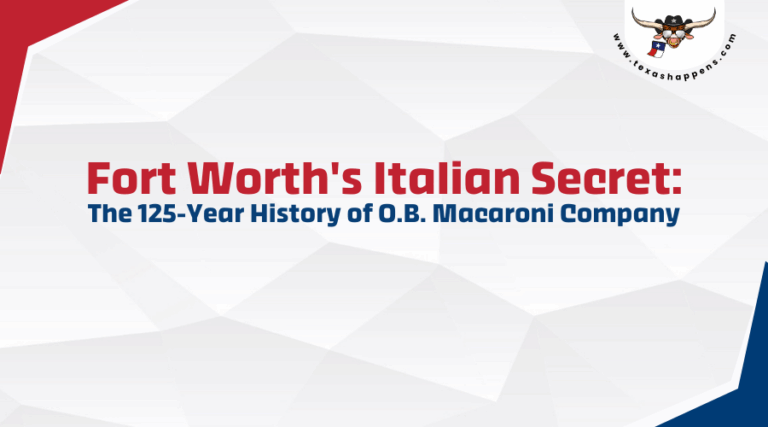O.B. Macaroni Company, founded in 1899 by Italian immigrants Louis (Luigi) Bicocchi and John B. (Giovanni) Laneri, grew from a small Fort Worth pasta factory into a regional icon. You’ll discover how generations of the Laneri family turned a Southside industrial site into a distinctive factory where “Our Best” became the beloved O.B. brand.
Though the Fort Worth factory ceased production in 2015 after roughly 110 years at the East Daggett site, its legacy continues through adaptive reuse as a vibrant mixed-use campus. This pasta empire’s story serves up surprising Fort Worth history.
From Old Stage Coach Hotel to Pasta Empire: The Founding Story
While many Fort Worth businesses have come and gone over the centuries, few embody the city’s industrial evolution quite like O.B. Macaroni. The company’s home did not begin as an 1860s stagecoach hotel; rather, the pasta operation launched as the Fort Worth Macaroni Company in 1899, and by 1904–1905 had moved production to East Daggett in the Near Southside.
This repurposing of historical structure took a pivotal turn as Bicocchi and John B. Laneri established large-scale pasta production at the new plant. Similar to how mixed-use development transformed Houston’s Greenway Plaza decades later, this early industrial siting showed foresight in urban growth.
Their original business model focused on quality pasta production, starting near Jennings and Daggett before consolidating at East Daggett. The company introduced the Our Best brand in the early 1900s, which would eventually be shortened to the iconic O.B. name that continues today.
The Family Behind the Fork: Four Generations of Laneri Leadership
View this post on Instagram
At the heart of O.B. Macaroni stands the Laneri legacy, beginning with John B. (Giovanni) Laneri, an Italian immigrant who helped co-found the business in 1899. After Laneri’s death in 1935, leadership remained within the extended family, sustaining the brand’s growth and community presence through mid-century.
Later Laneri family members continued expansion and distribution, maintaining philanthropic commitments—particularly to Catholic education and local causes—long associated with the Laneri name. Successive generations preserved the company’s reputation for consistency and value from its south Fort Worth location.
The company’s focus on quality also encompassed fideo/vermicelli products that became pantry staples in many Mexican-American households during the mid-20th century.
The family’s community engagement remains part of the firm’s identity in local memory, paralleling Fort Worth’s broader prosperity from cattle, meatpacking, oil, and aviation.
A Building Shaped by History: The Unique Triangular Factory
Standing as one of Fort Worth’s most architecturally distinctive industrial landmarks, the O.B. Macaroni factory features a recognizable wedge/triangular footprint dictated by its surroundings. The site’s geometry—framed by intersecting streets and nearby rail lines—encouraged an unconventional plan that maximized an irregular lot.
Built out as a pasta factory circa 1905, the brick structure showcases segmental-arched windows that brought natural light to production floors. Proximity to rail aided distribution throughout the Southwest, aligning with the company’s regional reach.
The firm formally adopted the O.B. Macaroni Co. name by the mid-20th century, reflecting the popularity of the “Our Best” label. Much like the USS Texas (BB-35) underwent significant modernizations in 1925, the factory received periodic upgrades to maintain operational efficiency.
Over its century of continuous use, the building has evolved from a pasta plant to a mixed-use development while preserving its distinctive shape—a monument to adaptive industrial architecture.
“Our Best” Becomes O.B.: The Evolution of an Iconic Brand
View this post on Instagram
Though many local businesses change over time, few transformations capture a company’s essence as perfectly as Fort Worth Macaroni Company’s evolution into O.B. By the 1950s, the company was widely known by its “Our Best” initials, and the abbreviated mark became the brand Texans trusted for pasta at a fair price. This shift wasn’t just convenient; it represented the Laneri family’s commitment to quality that fueled tremendous brand loyalty across the Southwest.
As one of the region’s longstanding pasta manufacturers, O.B. Macaroni expanded into:
-
Macaroni cuts that became kitchen staples
-
Spaghetti and linguine that competed with national brands
-
Specialty shapes tailored to evolving regional tastes
This strategic brand focus unified their identity while preserving the family’s Italian heritage that had defined Fort Worth’s food landscape for generations. After operating for about 110 years in the historic building, the factory shut down in 2015, making way for new uses of the space.
Revitalization and Renaissance: New Life for Fort Worth’s Oldest Pasta Factory
When the doors of the century-old O.B. Macaroni factory finally closed in 2015, you might’ve thought Fort Worth had lost a piece of its industrial heritage forever. Instead, entrepreneurs Jessica Miller Essl and Susan Miller Gruppi of M2G Ventures saw an opportunity for adaptive reuse that would honor the building’s pasta-making legacy while creating something new.
The three-story brick structure with its distinctive arched windows now anchors a community-driven transformation, opening to local makers, culinary concepts, and creative businesses. This mixed-use campus cleverly maintains the building’s production roots while creating a vibrant hub for Near Southside enterprises. Constructed as an early-1900s factory, the building ranks among the older industrial structures still standing in Fort Worth.
The phased development preserves architectural character while boosting the Near Southside’s economic importance, proving that Fort Worth’s industrial past can successfully evolve.


